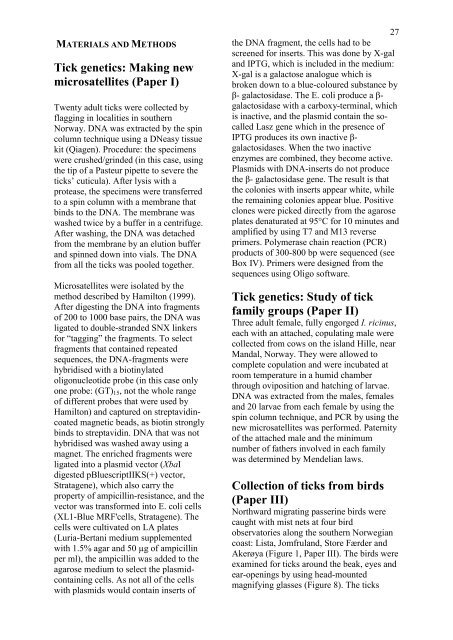dispersal of ticks and tick borne diseases by birds - Lista fuglestasjon
dispersal of ticks and tick borne diseases by birds - Lista fuglestasjon
dispersal of ticks and tick borne diseases by birds - Lista fuglestasjon
You also want an ePaper? Increase the reach of your titles
YUMPU automatically turns print PDFs into web optimized ePapers that Google loves.
MATERIALS AND METHODS<br />
Tick genetics: Making new<br />
microsatellites (Paper I)<br />
Twenty adult <strong><strong>tick</strong>s</strong> were collected <strong>by</strong><br />
flagging in localities in southern<br />
Norway. DNA was extracted <strong>by</strong> the spin<br />
column technique using a DNeasy tissue<br />
kit (Qiagen). Procedure: the specimens<br />
were crushed/grinded (in this case, using<br />
the tip <strong>of</strong> a Pasteur pipette to severe the<br />
<strong><strong>tick</strong>s</strong>’ cuticula). After lysis with a<br />
protease, the specimens were transferred<br />
to a spin column with a membrane that<br />
binds to the DNA. The membrane was<br />
washed twice <strong>by</strong> a buffer in a centrifuge.<br />
After washing, the DNA was detached<br />
from the membrane <strong>by</strong> an elution buffer<br />
<strong>and</strong> spinned down into vials. The DNA<br />
from all the <strong><strong>tick</strong>s</strong> was pooled together.<br />
Microsatellites were isolated <strong>by</strong> the<br />
method described <strong>by</strong> Hamilton (1999).<br />
After digesting the DNA into fragments<br />
<strong>of</strong> 200 to 1000 base pairs, the DNA was<br />
ligated to double-str<strong>and</strong>ed SNX linkers<br />
for “tagging” the fragments. To select<br />
fragments that contained repeated<br />
sequences, the DNA-fragments were<br />
hybridised with a biotinylated<br />
oligonucleotide probe (in this case only<br />
one probe: (GT)15, not the whole range<br />
<strong>of</strong> different probes that were used <strong>by</strong><br />
Hamilton) <strong>and</strong> captured on streptavidincoated<br />
magnetic beads, as biotin strongly<br />
binds to streptavidin. DNA that was not<br />
hybridised was washed away using a<br />
magnet. The enriched fragments were<br />
ligated into a plasmid vector (XbaI<br />
digested pBluescriptIIKS(+) vector,<br />
Stratagene), which also carry the<br />
property <strong>of</strong> ampicillin-resistance, <strong>and</strong> the<br />
vector was transformed into E. coli cells<br />
(XL1-Blue MRF'cells, Stratagene). The<br />
cells were cultivated on LA plates<br />
(Luria-Bertani medium supplemented<br />
with 1.5% agar <strong>and</strong> 50 µg <strong>of</strong> ampicillin<br />
per ml), the ampicillin was added to the<br />
agarose medium to select the plasmidcontaining<br />
cells. As not all <strong>of</strong> the cells<br />
with plasmids would contain inserts <strong>of</strong><br />
27<br />
the DNA fragment, the cells had to be<br />
screened for inserts. This was done <strong>by</strong> X-gal<br />
<strong>and</strong> IPTG, which is included in the medium:<br />
X-gal is a galactose analogue which is<br />
broken down to a blue-coloured substance <strong>by</strong><br />
- galactosidase<br />
with a carboxy-terminal, which<br />
is inactive, <strong>and</strong> the plasmid contain the socalled<br />
Lasz gene which in the presence <strong>of</strong><br />
IPTG produces itgalactosidases.<br />
When the two inactive<br />
enzymes are combined, they become active.<br />
Plasmids with DNA-inserts do not produce<br />
- galactosidase gene. The result is that<br />
the colonies with inserts appear white, while<br />
the remaining colonies appear blue. Positive<br />
clones were picked directly from the agarose<br />
plates denaturated at 95°C for 10 minutes <strong>and</strong><br />
amplified <strong>by</strong> using T7 <strong>and</strong> M13 reverse<br />
primers. Polymerase chain reaction (PCR)<br />
products <strong>of</strong> 300-800 bp were sequenced (see<br />
Box IV). Primers were designed from the<br />
sequences using Oligo s<strong>of</strong>tware.<br />
Tick genetics: Study <strong>of</strong> <strong>tick</strong><br />
family groups (Paper II)<br />
Three adult female, fully engorged I. ricinus,<br />
each with an attached, copulating male were<br />
collected from cows on the isl<strong>and</strong> Hille, near<br />
M<strong>and</strong>al, Norway. They were allowed to<br />
complete copulation <strong>and</strong> were incubated at<br />
room temperature in a humid chamber<br />
through oviposition <strong>and</strong> hatching <strong>of</strong> larvae.<br />
DNA was extracted from the males, females<br />
<strong>and</strong> 20 larvae from each female <strong>by</strong> using the<br />
spin column technique, <strong>and</strong> PCR <strong>by</strong> using the<br />
new microsatellites was performed. Paternity<br />
<strong>of</strong> the attached male <strong>and</strong> the minimum<br />
number <strong>of</strong> fathers involved in each family<br />
was determined <strong>by</strong> Mendelian laws.<br />
Collection <strong>of</strong> <strong><strong>tick</strong>s</strong> from <strong>birds</strong><br />
(Paper III)<br />
Northward migrating passerine <strong>birds</strong> were<br />
caught with mist nets at four bird<br />
observatories along the southern Norwegian<br />
coast: <strong>Lista</strong>, Jomfrul<strong>and</strong>, Store Færder <strong>and</strong><br />
Akerøya (Figure 1, Paper III). The <strong>birds</strong> were<br />
examined for <strong><strong>tick</strong>s</strong> around the beak, eyes <strong>and</strong><br />
ear-openings <strong>by</strong> using head-mounted<br />
magnifying glasses (Figure 8). The <strong><strong>tick</strong>s</strong>


